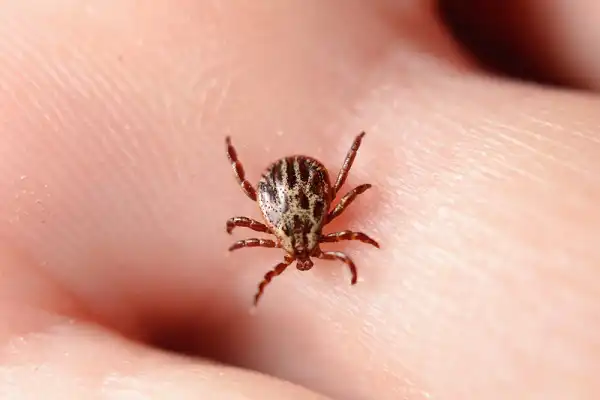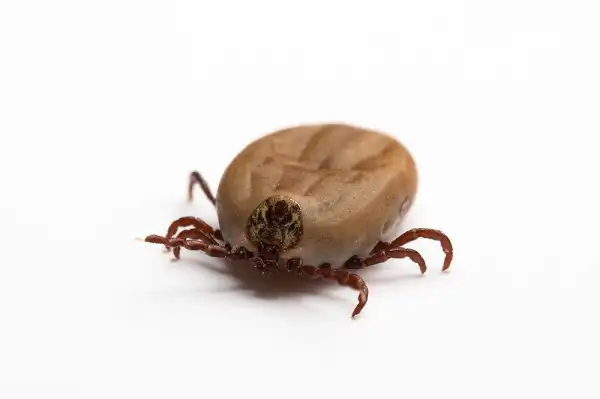What comes to mind when you think of a wood tick? Is it the tiny but determined arachnid bent on finding its next meal? Or maybe a memory of being tickled by an enthusiastic outdoorsman excited to show off their favorite critter. No matter your experience, these pocket-sized creatures can cause quite a stir. Wood ticks are more than just curious bugs; they are known for their ability to transmit Lyme and other diseases that can have long-term effects if left untreated. In this blog post, we’ll explore how wood ticks live and what you should do if one finds its way onto your skin. So read on, take notes, and arm yourself with the knowledge that may soon come in handy!

Wood Tick Description
Wood ticks are small arachnids. They have eight legs, a head and body region, and two antennae. Their bodies are dark in color, ranging from grey to brown to black. They possess an oval-shaped plate on their back which is known as a scutum that is used for protection when they feed. Wood ticks also have a pair of barbed mouthparts known as chelicerae that are used to attach themselves to hosts and draw out blood meals.
Wood Tick Habitat
Wood ticks are typically found in wooded areas, especially areas with low-lying vegetation like ferns or tall grass. They inhabit forests, meadows, and backyards throughout the United States. Wood ticks prefer to live in moist areas with high levels of humidity and a warm climate. In fact, they thrive in temperatures between 65°F and 80°F. Wood ticks often attach themselves to hosts walking through their habitats, meaning they can be found anywhere people or animals may roam. They’re also known to hide in logs, brush piles, leaf litter, and other shady spots where they can wait for a host to come along. Generally speaking, wood ticks will not travel far from their habitat; once they have a host they will typically stay on that host until it feeds again or is brushed off. Wood ticks are most active during the warmer months of the year when temperatures reach their peak; however, adult wood ticks may remain inactive during colder months if temperatures drop below 50°F for an extended period of time. During these dormant stages, wood ticks can survive without food for months at a time by using stored fat deposits within their bodies as energy sources.
Wood Tick Diet
Wood ticks feed exclusively on the blood of mammals, birds, lizards, and amphibians. They use their sharp chelicerae to attach to a host’s skin and then inject an anticoagulant which helps ensure a continuous flow of blood for them to consume. Wood ticks can consume up to 3 times their body weight in a single feeding session. Adult wood ticks will typically take several days to complete a meal while larvae and nymphs usually require multiple meals before they are able to molt into the next stage of their life cycle. Once a wood tick has had its fill of blood it will detach itself from its host and fall off. If no other suitable hosts are available, adult wood ticks will enter into diapause (a period of suspended development) until conditions become more favorable for them to find another host.

Wood Tick Size
Wood ticks range in size from 1/8 of an inch to 3/16 of an inch, with the nymph stage being the smallest. The average size of a wood tick is only about the size of a pencil eraser or grain of rice. Adult wood ticks are typically dark in color and possess an oval-shaped plate on their back called a scutum, while larvae and nymphs are usually much lighter in color and lack any kind of protective covering. They have 8 legs with 2 antennae, as well as a pair of barbed mouthparts called chelicerae that they use to attach themselves to hosts and draw blood meals.
Wood Tick Lifespan
Wood ticks have a relatively short lifespan compared to other species of arachnid. Adult wood ticks typically live for about 1 year, while larvae and nymphs may only last for a couple of months before they molt into the next stage. The lifecycle of a wood tick begins with an egg hatching into a six-legged larva, which then feeds on small insects until it is ready to molt into an eight-legged nymph. The nymph will go through multiple feeding sessions before molting again into an adult. Adult wood ticks are capable of traveling far distances in search of a host and can remain attached to them for several days or even weeks as they feed. After their blood meal is complete, adult wood ticks detach from their host and return back to their habitat to lay eggs and start the cycle anew.
Wood Tick Behavior
Wood ticks have a range of behaviors that are important to understand in order to protect oneself from potential diseases. When searching for hosts, wood ticks will often stand on vegetation and wait with their front legs raised in what is referred to as the “questing” position. They use chemical signals known as pheromones to detect a suitable host and then latch on with their chelicerae when they find one. Once attached, wood ticks can feed for several days or even weeks at a time depending on the species and location of the tick. During this time the tick will take multiple blood meals, and it can consume up to three times its body weight in one session. Once it is finished feeding, it will detach itself from its host before returning to its habitat.
Wood ticks can also transmit vector-borne diseases during their feeding sessions by passing pathogens into their host’s bloodstream. Some of these illnesses include Lyme Disease, Rocky Mountain Spotted Fever, Tularemia, and Ehrlichiosis; all of which can cause serious symptoms if left untreated. As such, it is important to take note of any signs you experience after being bitten by a wood tick as it could be an indication of serious illness.

Wood Tick Speed
Wood ticks, like many other arachnids, have relatively slow movement speeds when compared to that insects or animals. Adult wood ticks can usually crawl around at a pace of 1-2 inches per minute while larvae and nymphs are slightly slower, moving around 0.5 – 1 inch per minute. This comparatively slow speed is primarily due to their small size; adult wood ticks measure just 3/16 of an inch in length while their nymph and larval counterparts are even smaller.
Wood Tick Hunting
Wood tick hunting involves searching for and identifying wood ticks in a given area. These critters can be found in grassy, wooded, or damp areas, usually near the ground where they are able to latch onto potential hosts. They typically measure just 3/16 of an inch when fully grown and stand with their front legs raised in the air as they wait for a suitable host to pass by. When hunting for wood ticks, it is important to take certain precautions such as wearing long-sleeved shirts and pants as well as applying insect repellent. It is also important to inspect yourself after being outdoors, particularly in areas where vector-borne diseases like Lyme Disease may be prevalent. It is also advised to carry a pair of tweezers or fine-pointed forceps with you while out in nature; these can be used to carefully remove any attached ticks and help avoid potential infections. Wood tick hunting can be done by using visual cues, such as noticing them on vegetation or hosts; or by using traps that are designed specifically for arachnids like ticks. Such traps usually consist of an adhesive material that will help capture any wood ticks that crawl over them, allowing them to then be safely removed from the environment. Additionally, some traps come with attractants that make them more attractive to the insects, increasing their chances of detecting one if present in the area.
Wood Tick Potential Health Risks
Wood ticks have the potential to transmit a range of vector-borne diseases through their saliva after taking multiple blood meals. Some of the most common illnesses that can be spread in this way include Lyme Disease, Rocky Mountain Spotted Fever, Tularemia, and Ehrlichiosis. Lyme Disease is the most commonly transmitted vector-borne disease from wood ticks and it is caused by bacteria known as Borrelia burgdorferi. It typically begins with flu-like symptoms such as fever, fatigue, headache, muscle pain, and swollen lymph nodes; although if left untreated it can lead to more serious complications like neurological disorders or even heart problems. Rocky Mountain Spotted Fever (RMSF) is another vector-borne illness that can be spread by wood ticks. It usually starts with a sudden onset of fever, headache, nausea, and vomiting as well as a rash that appears on the wrists and ankles.
If not treated promptly it can cause serious damage to vital organs including the liver and kidneys. Tularemia is another potentially fatal illness that may be transmitted via wood tick bites. Symptoms typically include fever, chills, muscle aches, fatigue, and vomiting; however, more severe cases can cause pneumonia or skin ulcerations near the site of infection. Ehrlichiosis is an infectious bacterial disease that can also be passed on by wood ticks. Initial symptoms are often similar to those associated with Lyme Disease but may also include confusion or other neurologic issues if left untreated for too long. In rare cases, this infection may also cause organ failure which could prove fatal if not managed quickly enough.

Conclusion
Wood ticks are small but dangerous parasites that can spread a range of vector-borne diseases to their hosts. Understanding wood tick behavior and taking the necessary precautions when spending time outdoors can help reduce your risk of exposure and potential infection. Hunting for wood ticks requires patience, caution, and an understanding of how they move in order to safely remove any potentially infected critters from the environment. Additionally, it is important to take note of any signs you experience after being bitten by a wood tick in order for prompt diagnosis and treatment should any vector-borne illnesses develop as a result of exposure. By following these guidelines, people can enjoy nature while protecting themselves against potential health risks associated with wood ticks.
Frequently Asked Question


